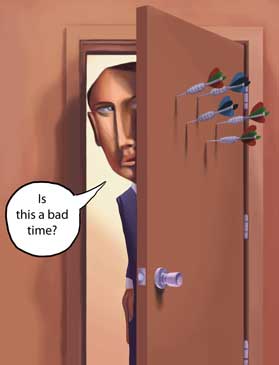Bradley was failing, and failing badly. Not only did the members of his team avoid him in the lunchroom and never stop by to say “good morning,” they had begun taping a target to his back every day and everyone had signed up for archery lessons. Bradley’s leadership style just wasn’t working.
Unfortunately, Bradley’s core problem was that he suffered from several leadership myths he’d picked up from pop culture. Like many of us, he didn’t have any formal training in leadership so his beliefs came mostly from watching movies. Leadership to Bradley was square-jawed men taking on insurmountable odds, rallying the troops with award-winning speeches, and humbly waiting for passionate kisses from pretty co-stars. Bradley thought he was prepared to be a great leader because though he didn’t have a square jaw and no one had tried to kiss him in years, he had been practicing his motivational speeches in the mirror. He had worked up his volume to “passing car with the bass too loud” level, and he could spew out all of the latest leadership buzzwords without spitting too much. But somehow it just wasn’t working.
What Bradley didn’t realize was that his ailments were completely fixable. They are pretty common today. Perhaps you’ve seen these leadership myths in your workplace:
The Myth of Omnipotence
This shouldn’t be confused with the “myth of ominipresence” (the power to be everywhere) or the “myth of omniplexes” (the power to watch all of the movies in a theater on only one ticket). The myth of omnipotence is thinking you can tell anyone on the team to do practically anything and they’re going to just hop to it, with a grin and a nod and a comment that means “You got it, boss. I’d walk through fire for you.”
It might happen in the movies but we know in reality a brand new leader doesn’t automatically get enthusiastic cooperation. He or she more often gets quiet acceptance, or perhaps begrudging compliance. Building cooperation and energetic participation requires time and careful nurturing in the real world. You might have to listen to a co-worker tell that unfunny story about their nephew’s brief stint with the Ice Capades. You might have to not get your way a few times in order to “collaborate” with your team. Real humans don’t give blind obedience because of someone’s position in an organizational chart. And leaders can’t alienate people, even if they do suspect some of them might be possessed by aliens.
The Myth of Omniscience
This is the belief that being the leader means knowing everything about everything. It comes in two varieties. In some environments, it makes the brand new leader micromanage and attempt to oversee the smallest detail. In others, it makes the leader think they have to know the answer to every question. Why else would they be the leader?
Bradley had these two issues. He started looking over everyone’s shoulder. Bradley also never failed to give an answer even when he was clueless. His staff noticed. They even started reading questions from the back of a quantum physics text book just to mess with him.
The Myth of Omni-adrenaline
This is probably the most damaging myth in today’s complex, skill-driven team environments. It is the belief that excellent execution from a team demands adrenaline surges, rousing speeches and lots of shouting. Every movie has such inspirational moments and Bradley tried to create them every day. Unfortunately, it didn’t seem to work on his team.
Bradley’s attempts at motivating were actually hurting his team’s performance, not helping. Shouting and adrenaline surges are only useful for invoking over-learned, mindless performance in the face of fear and actual physiological arousal. Military units and sports teams are perfect for this type of leadership. They also provide clear winners and losers and are wonderful backdrops for the kind of dramatic storytelling Hollywood thrives on. Would you want to see a movie about complex, skill-driven teams toiling day after day to solve logistics issues, problems with customer service, or trying to get the copier man to arrive on time?
But adrenaline surges also narrow cognition and thinking. Today’s American work environment demands creative problem solving, flexible decision making and complex reasoning. When was the last time you had to jump on a grenade or charge into an enemy bayonet line? A leader suffering from “omni-adrenaline” in the modern workplace looks clueless and simple-minded. “Why is he shouting? I’m trying to concentrate over here!”
Americans and movie watchers worldwide are taught myths about leadership every day. The myths of omnipotence, omniscience and omni-adrenaline are just a few of the leadership stereotypes that can be fixed with training or mentorship. Fortunately, these “inoculations” are available in all kinds of dosage sizes. Everyone can get access to leadership training in today’s technology-connected world. And why not? Wouldn’t you want to create a more productive, cooperative workplace by dispelling the myths of leadership you suffer from?


